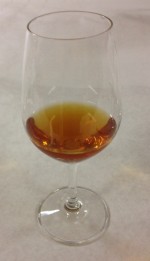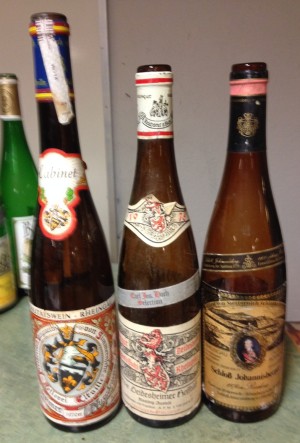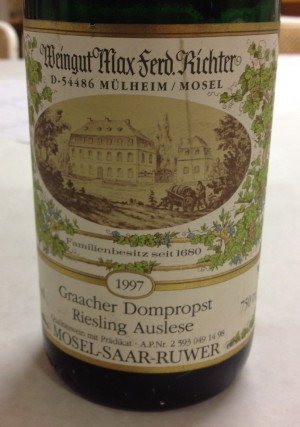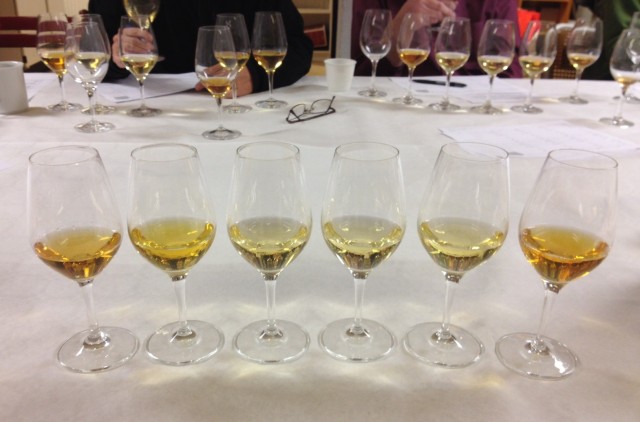 One of the out-of-town members of our wine tasting club, who blogs about wine for a regional newspaper and therefore regularly “comes to town” to taste new arrivals, arranged a tasting on the theme “mature Riesling”. In this case, “mature” didn’t refer to adolescent wines of 10-15 years, but to those that were mature for real. The vintages of the ten regular wines of the tasting stretched from 1929 to 1986, with 1971.8 being the average vintage. (1974.1 if I include a youngish extra wine of the 1997 vintage.) All wines were German Rieslings with varying degree of residual sugar, with Prädikate ranging from Kabinett to Beerenauslese.
One of the out-of-town members of our wine tasting club, who blogs about wine for a regional newspaper and therefore regularly “comes to town” to taste new arrivals, arranged a tasting on the theme “mature Riesling”. In this case, “mature” didn’t refer to adolescent wines of 10-15 years, but to those that were mature for real. The vintages of the ten regular wines of the tasting stretched from 1929 to 1986, with 1971.8 being the average vintage. (1974.1 if I include a youngish extra wine of the 1997 vintage.) All wines were German Rieslings with varying degree of residual sugar, with Prädikate ranging from Kabinett to Beerenauslese.
This wine tasting club, AuZone, definitely includes the odd wine n*cr*philiac, but also there, it is definitely not common to encounter 1929s. It’s fair to say that wines up to about 30 years of age show upp rather regularly, and that wines from the 1970s (about 40 years of age) show up now and then. Anything older than that is quite rare. From the 2013 tastings I particpated in I remember a 1947 Massandra wine of “white Port” type and a (red and bona fide) 1966 Vintage Port, but nothing older. In the 2012 tasting, some older sweet Loire wines from Moulin Touchais – vintages 1949, 1959, and 1964 – can have been the oldest. It was even more surprising with such an old wine, since it wasn’t a fortified wine. Good Riesling does indeed age with grace, and those with residual sugar usually age better than the dry ones. However, corks don’t live forever, so even if you have an ideal cellar I’d recommend to limit yourself to cellaring wines for up to 30-40 years rather than 80+. 🙂
 The wines were served in semi-blind flights (i.e., the order was not known). But first, the grand old lady of the evening was served open, and it came with the caution “a curiosity, no guarantees whatsoever!”
The wines were served in semi-blind flights (i.e., the order was not known). But first, the grand old lady of the evening was served open, and it came with the caution “a curiosity, no guarantees whatsoever!”
1929 Liebfraumilch Spätlese, Werger & Cie
Rheinhessen. Bottled by Werger & Cie, Worms, while the matching neck label indicates that the bottle was sold by Findlater Mackie Todd & Co. Ltd. in London, a company founded in 1823 that once consisted of a whole chain of wine shops. The company was bought in 1993 by Waitrose.
 The wine: amber colour. Nose with dried fruit, fried apples and old winter apples, hazelnuts, chocolate, petroleum, some smoke, burnt sugar and Madeira notes. The palate is off-dry(-) with rather good concentration, winter apples, high acidity, and oxidised notes. Obviously developed with old notes, the nose is better than the palate, but the palate also sticks together. Definite exciting to taste! An honest score based only what was in the glass: 86 p. “Experience points” with the age included: 95 ep.
The wine: amber colour. Nose with dried fruit, fried apples and old winter apples, hazelnuts, chocolate, petroleum, some smoke, burnt sugar and Madeira notes. The palate is off-dry(-) with rather good concentration, winter apples, high acidity, and oxidised notes. Obviously developed with old notes, the nose is better than the palate, but the palate also sticks together. Definite exciting to taste! An honest score based only what was in the glass: 86 p. “Experience points” with the age included: 95 ep.
Quite fascinating that this 85 year old wine was fully drinkable, if old in style. The nose reminded me quite a lot of Riesling from the 1950s and 1960s, on the Spätlese or Auslese level, that I have tasted over the last 5-10 years.
The subject of Liebfraumilch deserves some additional words. The short version is that in the beginning, Liebfraumilch was a good wine, and a 1929 Liebfraumlich shouldn’t be expected to be entirely similar to a Liebfraumilch from the 1950s or later. This wine should rather be considered as a 1929 Spätlese that also happens to be labelled Liebfraumilch, and it should be noted that German Spätlese in the 1950s and earlier tended to be heavier than these wines were in the 1960s to 1980s.
Now the longer version follows. Scroll down to the next flight if you don’t have a special interest!
The wines that have been designated Liebfraumilch in the last couple of decades aren’t too impressive, to put it mildly. The infamous Blue Nun (which today is likely to be both drier and better than its reputation) was a Liebfraumilch once upon a time, but they stopped using that designation a long time ago, since it was seen as negative for the brand. The modest requirement for being a Liebfraumilch today is that the wine is a Qualitätswein consisting of a minimum of 70% of the grape varieties Riesling, Silvaner, Müller-Thurgau, or Kerner, and originates from any of the wine regions of Nahe, Pfalz, Rheingau, or Rheinhessen. I can guarantee that there isn’t too much Riesling in a typical Liebfraumilch today, because the other permitted varietals are cheaper to buy in, and Liebfraumilch is produced by bulk producers, not by small growers who bottle their own wines.
Liebfrauenkirche in Worms with surrounding vineyards that are still owned by Valckenberg.
The designation Liebfrau(en)milch – apparently documented back to 1687 – originally referred to a wine from vineyards around the church Liebfrauenkirche in Worms in Rheinhessen. In the early 19th century, the wine merchant Valckenberg succeeded in buying much of these vineyards and established Liebfraumilch as a well-known brand on the export market. Around 1900 it seems to have still been considered a very good wine. The name wasn’t protected, though, and other producers started to call their wines Liebfraumilch as well. In 1909, Valckenberg established the brand “Liebfraumilch Madonna” which was exclusive to them. By the way, Blue Nun was launched with the 1921 vintage (an excellent vintage in both Germany and France), and was once considered a good wine. However, it was the mass-produced off-dry wines that ruined the international reputation of German wine from the 1970s, and even more in the 1980s.
Although 1929 Liebfraumilch can have meant anything in terms of origin, it is a Spätlese and it was bottled by a winery in Worms, the origin of the designation. Therefore, it is not entirely surprising that this bottle was filled with a good wine once upon a time. This 1929 could very well have been a varietal Riesling, and if it wasn’t I think it’s likely that it was a Riesling with some Silvaner blended into it.
The original vineyard around the Liebfrauenkirche is called Liebfrauenstift-Kirchenstück, and can be seen in the picture above. Today, it is a vineyard classified as a VDP Grosse Lage, which means that it can be used to produce top-class dry wines under the designation Grosses Gewächs. The vineyard consists of 14.3 hectares, almost completely consisting of Riesling. This can be compared to the 57 000 hectares from which today’s Liebfraumilch may be sourced.
Flight A: “A visit to the Doctor”
Some wine from Bernkasteler Doctor, the most famous vineyard in middle Mosel, and some other nearby vineyards.
1970 Bernkasteler Doctor Riesling Hochfeine Auslese, Freiherr von Schorlemer
Mosel-Saar-Ruwer (the name of the region in those days, before it was shortened to Mosel)
The colour is orange or light amber. Nose with petroleum, fried apples and winter apples, dried fruit, “firne” (old Riesling notes) and noticeable smoke notes. The palate is off-dry with winter apples, good acidity, and spice. Somewhat short with a certain bitterness in the aftertaste. Not too complex, but rather typical mature notes for an older Riesling. Honest score: 83 p.
Yes, the 1929 was better. I suppose that also here, the age might justify a slightly higher “experience score”: 86 ep.
Voting within the flight gave this wine 3 worst votes, including mine. (No best votes.)
I guessed that this wine was at Spätlese level. 1970 was a good vintage, although it is less known than 1971. That an Auslese from Mosel is able to handle some 40 years better than this wine was clearly demonstrated by the next wine:
1969 Wehlener Abtei Riesling Hochfeine Auslese, Klosterhofgut Wehlen
Mosel-Saar-Ruwer
Intense yellow colour. Nose with dominating notes of citrus and zest, some yellow apple, smoke, and various mature notes hovering in the background. The palate is semi-sweet with pronounced citrus notes, high acidity, viscous mouthfeel and a lot of depth. The aftertaste is long and citrus-dominated. Auslese style with development but with “Auslese+” weight, and with a lot of vigor and energy. 91 p.
Fabulously fresh for its age – this is how a mature Auslese should be!
5 best votes (including mine) and 1 worst vote, and thus voted the best wine of the flight (tied with 1983 Pauly-Bergweiler wine).
By the way, the designations hochfeine and hochfeinste (both adjectives of which the latter is the superlative form, the meaning is “very fine”) are sometimes seen together with the Auslese designation on pre-1971 wines, the year of a major reform of the German wine law. I’ve never seen them used on any younger wines. Since then, “Goldkapsel” and star designations seems to have taken over, and I interpret hochfeine Auslese as approximately Auslese ** and hochfeinste Auslese as approximately Auslese ***.
1983 Bernkasteler Doctor Riesling Auslese, Weingut J. Lauerburg
Mosel-Saar-Ruwer
Medium yellow colour. Nose with citrus, pronounced smoke notes, kerosene, elderflower, and slightly “sharp nose”. Off-dry palate, citrus including grapefruit, high acidity, good concentration. Fresh and somewhat lean style, my guess had been Spätlese if it wasn’t a Mosel wine. 88 p
Received 1 best and 2 worst votes.
1983 Bernkasteler Badstube Riesling Auslese, Weingut Dr. Pauly-Bergweiler
Mosel-Saar-Ruwer
Rather light yellow colour. Citrus-packed nose with pronounced notes of zest, some dried apricot and petroleum notes with kerosene. Off-dry palate, citrus and grapefruit, definitely high acidity, a long and fresh citrus aftertaste. A fresh style with a lot of citrus notes and decent weight. 89 p
Received 4 best votes and voted the best wine of the flight (tied with the 1969 Auslese above).
1986 Bernkasteler Doctor Riesling Kabinett, Wwe. Dr. H. Thanisch
Mosel-Saar-Ruwer
Medium yellow colour. Nose with citrus, other yellow fruit, pronounced smoke notes, some notes of dried wood. The palate is off-dry (-) with citrus, some mineral, not too concentrated, finishes with a light bitterness. Pleasant nose but a palate with a somewhat “hollow” structure compared to the other wines, as well as a drier style, so it wasn’t surprising that this was a Kabinett, i.e., a more lightweight wine. 85 p
Received 6 worst votes and was voted the worst wine of the flight.
1976 Brauneberger Juffer Sonnenuhr Riesling Beerenauslese, Freiherr von Schorlemer
Mosel-Saar-Ruwer
Intense orange colour. Nose with oranges, dried fruit, flowery with perfume notes, honey and a strong note of beeswax, some oxidation notes in the background. The palate is semi-sweet/sweet, rather viscous, with medium acidity, some spice, a rather long aftertaste and a hint of bitterness. The nose is a bit odd for a Riesling, and more aromatic than expected. Different and exciting, but a bit difficult to score – 89 p? with an addition of 91 “experience points” for the generous scorer.
3 best and 1 worst votes.
This wine went somewhat in the direction old sweet Muscat or Gewürztraminer, without going all the way, so I started to think about a blend of Riesling and some more aromatic varietal. Admittedly, it’s not very easy to find such blends, at least not at higher levels of sweetness.
Flight B: Rheingau and Pfalz
 Rheingau and Pfalz usually produce wines in a slightly heavier style than Mosel does.
Rheingau and Pfalz usually produce wines in a slightly heavier style than Mosel does.
1970 Hattenheimer Nussbrunnen Cabinet, Freiherr Langwerth von Zimmern
Rheingau
Deep but bright yellow colour. Nose with citrus, noticeable smoke, yellow apple, some dried fruit, petroleum, and some beeswax. Off-dry palate, yellow apple, citrus, high acidity, a long and fresh citrus aftertaste, and some some old wine notes (firne) in the palate. Fine development and fine balance, Spätlese style, foody. 89 p (91 “experience points” since it is a wine carrying a designation that was retired in 1971.)
In this flight it received 6 best and 7 worst votes (including mine) and therefore the wine that was met with the most divided opinions.
Comment: until 1970, Cabinet, usually written with “C”, designated a better wine that had been put away to be sold later, corresponding to how the designation “Reserve” is used (or at least was meant to be used) in many countries. It was an additional designation and not a Prädikat in its own right, so on older bottles combinations like Trockenbeerenauslese Cabinet can be seen. Kabinett, always with a “K”, was introduced in 1971 as the lowest Prädikat in terms of grape ripeness, and at the same time the requirements for a Spätlese (the next level) was set rather low for a designation which literally means “late harvest”. When a pre-1971 wine just says Cabinet without any Prädikat, it usually corresponds to a Spätlese using the standards of 1971, since the better wines (those put away for Cabinet status) tended to be higher in ripeness than the basic level.
1976 Deidesheimer Hofstück Riesling Auslese, Rechsrat von Buhl
Rheinpfalz (the name was later shortened to Pfalz, and is also known in English as the Palatinate)
Golden colour with some amber notes. Nose with yellow winter apples, some dried fruit, milk chocholate, spice, petroleum, and some smoke. Semi-sweet palate, good weight, spice, yellow apple, dried, fruit, good acidity, slightly green-apply aftertaste with hard acidity, some oxidation notes and a hint of bitterness. Developed style with both hot and cool vintage signs, despite being of distinctly hot vintage. 90 p
Received 5 best and 2 worst votes, and therefore voted the best wine of the flight.
This was the heaviest wine of these three, so I thought this was the one from Schloss Johannisberg, since the tradition of going quite high in sweetness is more common in Rheingau than in Pfalz. Or at least that was what I thought, I’m not 100% sure about how things stood in 1976. On top of that, the alcohol could be felt a bit more in the next wine, which seemed to fit with putting that one in Pfalz.
1976 Schloss Johannisberger Riesling Rosalack Auslese
Rheingau
Deep golden colour with amber. Nose with honey, oranges, dried yellow fruit, some smoke, petroleum, beeswax, discrete flowery notes – a heavy and elegant nose. The palate is off-dry plus, shows some alcoholic fire (when compared to the other two), spice, high acidity, notes of winter apples and yellow apples, and a good acidity in the aftertaste. Good balance, 90 p.
Somewhat less sweet than the previous wine.
Received 2 best votes (including mine) and 4 worst votes, and therefore voted the least good wine of the flight.
 As an unusually young extra wine, we finished with:
As an unusually young extra wine, we finished with:
1997 Graacher Dompropst Riesling Auslese, Weingut Max Ferd. Richter
Mosel-Saar-Ruwer
Nose with citrus, yellow apple, some smoke, and petroleum. The palate is off-dry plus with citrus, in particular grapefruit, high acidity, and a long and fresh aftertaste. 89 p
Truly a great tasting! Older Riesling can definitely be very fascinating.




Hi have a bottle you might be interested in . It’s a Liebfraumilch glockenspiel 1929
Just wondering if you could give me any information on it
Thanks Derek
I’m afraid I don’t have any info, other than that 1929 Liebfraumilch could be drinkable 9 years ago. 🙂 It’s probably best that you ask a nearby wine auctioneer if you’re interested in selling your bottle, rather than drinking it yourself with interested friend.